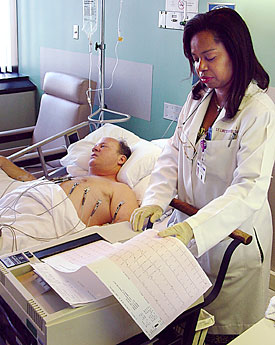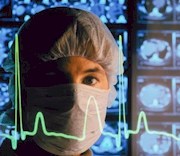|

|
|
An electrocardiogram (ECG or EKG) test.
|
An electrocardiogram (ECG or EKG) is a routine test that is used to look at the electrical activity of the heartbeat. An electrocardiogram can tell your doctor a lot about your heart and how it is working. This test can help your doctor learn more about your heart rhythm, the size and function of the chambers of your heart, and your heart muscle. A healthy person's electrocardiogram has a certain pattern. When there are changes in that pattern, your doctor can tell that there is a problem with your heart. For example, during a heart attack, the EKG machine records the changing pattern of the heart's electrical activity.
How does it work?
For your heart to beat, an electrical impulse is sent from the sinoatrial (SA) node, which is located in your heart. The SA node helps your heart keep a steady pace. An electrocardiogram can trace the path of electrical energy that is sent from the SA node and through your heart. This lets your doctor know whether you have a problem that might cause your heart to beat irregularly.
Small metal disks called electrodes are placed on your skin. The electrodes are used to pick up the electrical impulses of the heart. The impulses are recorded, giving doctors a record of your heart's electrical activity.
|

|
|
An electrocardiogram (ECG or EKG) tracing.
|
|
What should I expect?
No special preparation is needed before you have an electrocardiogram.
During the test, you will lie on an examination table. A technician will clean the areas on your body where the electrodes will be placed, usually your chest, back, wrists, and ankles. The electrodes have wires called leads, which hook up to the electrocardiogram machine.
Once the electrodes are in place, you will be asked to lie down. The technician will enter some information into the electrocardiogram machine and then tell you to lie still for about a minute while the machine takes its readings. The test is completely safe and painless.
See on other sites:
MedlinePlus
https://medlineplus.gov/ency/article/003868.htm
Electrocardiogram
Updated August 2016



